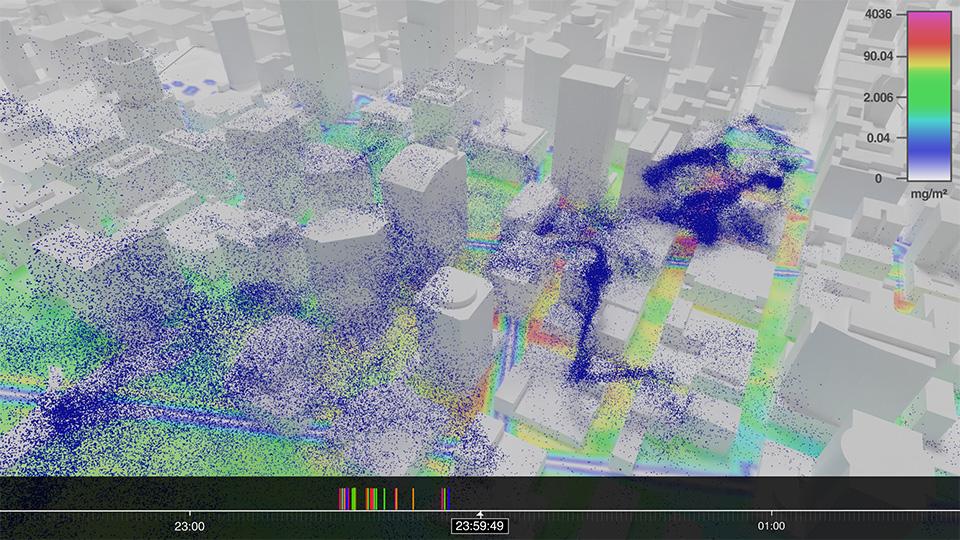New investigation shows dangerous levels of teargas used by US police
Primary page content
Forensic Architecture has published a new visual investigation, analysing the amount of tear gas used by police to shut down ‘Black Lives Matter’ protests in Portland, Oregon on June 2, 2020.

Using computer fluid dynamics, FA and Imperial College London simulated the movement of CS particles across downtown Portland as a result of the actions of Portland’s police, the PPB. (Forensic Architecture, 2023)
Goldsmiths research agency Forensic Architecture (FA) created a visual 3D simulation of the Portland police bureau’s (PPB) use of teargas during the major protest event, showing that the area was covered with gas at more than 50 times the level federal regulators consider “immediately dangerous to life or health”.
FA worked with weapon experts to analyse hundreds of videos from that evening, along with internal police files, invoice records, manufacturer data and photos of teargas canisters.
On 2 June 2020, peaceful protests turned into a public health emergency, on a day which became known locally as ‘Tear Gas Tuesday’. The police's extensive use of chemical munitions led to widespread reports of enduring physical and mental health impacts.
FA worked with international partners to develop a new methodology to reveal how tear gas moves through urban environments, and to reveal the potentially lethal concentrations that civilians can be exposed to.
The latest investigation combines open source investigation with advanced ‘fluid dynamics’ simulations to accurately reconstruct and simulate the spread of toxic chemicals across downtown Portland, to demonstrate how tear gas used by the PPB subjected civilians to concentrations of CS – one of the most common ‘tear gas’ chemicals – hundreds of times higher than the federal government considers safe.
Jasper Humpert, assistant researcher with Forensic Architecture, said: “The ability to recreate and visualise the use of chemical weapons on civilian protestors is an important step in pushing back against the excessive use of force we saw during the Portland protests as well as in other sites across the US during the 2020 racial justice protests.
“With our digital tools at hand, we seek to make evident the gross violations of power and it is a crucial message to police forces around the world that the civil society holds the means to investigate and expose, and that their actions will not pass unchecked.”
The investigation concluded that:
- In just two and a half hours on the evening of 2 June 2020, the PPB used at least 148 munitions containing ‘tear gas’ chemicals in an area of 18 blocks of downtown Portland.
- According to FA’s fluid dynamics simulation, PPB’s use of tear gas resulted in airborne CS concentrations as high as 4568mg/m3, and consistently well above the 2mg/m3 level considered ‘immediately dangerous to life and health’ (‘IDLH’) by the federal Occupational Safety and Health Administration.
- The simulation suggests that CS particles would have carried more than 800m across Portland on that day, following the prevailing winds, as well as hanging suspended between buildings in downtown Portland for hours after their use.
- According to the simulation, more than 2kg of CS would have been deposited in the Willamette River, near to the protest areas, on 2 June alone. - Documents released by the PPB in 2020 reveal that the institution was aware of the existence of the 2mg/m3 ‘IDLH’ threshold.
Robert Trafford, an assistant director with Forensic Architecture, said: “Chemical munitions – sometimes called ‘tear gas’ – are banned in international conflict, but police can use them on US streets with little oversight. The excessive use of chemicals against civilians in this way – which we saw throughout the 2020 protests, and across the US – is first and foremost an admission of the bankruptcy of contemporary policing tactics.
“What’s more, the astonishing concentrations revealed in our simulation suggest a complete lack of understanding by PPB officers of the dangers of these chemicals, flying in the face of federally-recognised public safety standards. Portland – and Oregon – should make amends for this appalling violence, by starting the US on the path to outlawing these chemical munitions.”
The full visual investigation is available on the Forensic Architecture website.